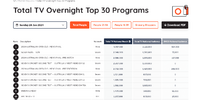- Moderator
- #1
There are changes coming as the whole ratintgs system moves over the VOZ.

 www.mediaweek.com.au
www.mediaweek.com.au
The way Australian TV audiences are measured will change significantly next week as OzTAM embraces Total TV audience reach in a bid to provide greater engagement measurement for marketers.
From Monday 29 January, OzTAM will launch two new daily VOZ website reports that provide Total TV Overnight and 7-day reach totals in addition to the top program rankings.
The official home of TV audience measurement telegraphed the changes last year. However, exact details about what the new publicly available data would include were kept under wraps.
OzTAM said at the time: “Learnings from [the testing] phase will determine the launch timing, anticipated in calendar 2024.”
In a briefing to Mediaweek yesterday, OzTAM revealed that four weeks into 2024 the VOZ button is being pressed. The changes will see Mediaweek and other publications switch to the VOZ reports from Monday, however, media agencies will continue to use TAM ratings until internal agency trading systems are updated. It is uncertain how long this cross-over of different metrics will last.
The changes will mean that daily TV ratings data, which are currently eleased just after 9am with an embargo of 10am, will no longer be available. The VOZ Total TV figures will now be released by 11.35am by OzTAM.
The changes come just before Foxtel’s launch of its new ratings data collected by Kantar. Those first figures could be just days away. It is not expected the Foxtel panel data will be released daily.
The biggest challenge OzTAM has faced over the years has been keeping pace with the changing way audiences are consuming entertainment on a growing range of digital devices.
Running OzTAM for 12 years was Doug Peiffer who stepped down as CEO last July. His time in the role saw him work on the evolution of online-delivered broadcast content (BVOD) measurement and Australia’s all-screen, cross-platform Total TV database, VOZ.
That was just part of the role. Another part was being mindful of the competing interests of the three OzTAM partners – Seven, Nine and now Paramount ANZ.
Running OzTAM since the end of November 2023 has been new CEO Karen Halligan. She joined the audience data collector from KPMG.
The starkest example of differences in the OzTAM boardroom was the push for a national TV audience figure. Seven’s James Warburton has been strident in his criticisms of the data OzTAM released. He often claimed the audience measurement numbers being released were the smallest possible figures. That is about to change.
See also: Everything you need to know – OzTAM launches VOZ viewing data
The new VOZ Total TV reports feature:
1) Total TV Overnight Top 30 programs
• Free-to-air programs ranked on National Total TV reach
• Total TV National and BVOD audience thousands for the top 30 programs
• Overnight National cumulative reach of Total TV, Broadcast TV and BVOD to be broken out at top of the report
• Demographics: Total Ppl, Ppl 25-54, Ppl 16-39, Grocery Shoppers (18+)
2) Total TV Consolidated 7 Top 30 programs
• Free-to Air programs ranked on National Total TV reach for the most recent Consolidated 7-day
• Total TV National and BVOD audience thousands for the top 30 programs over the most recent Consolidated 7-day period
• 7-day National cumulative reach of Total TV, Broadcast TV and BVOD to be broken out at top of the report
• Demographics: Total Ppl, Ppl 25-54, Ppl 16-39, Grocery Shoppers (18+)
Total TV includes National Broadcast TV and National BVOD.
From January 29 OzTAM will cease production of the daily Overnight and Consolidated viewing reports, including the Daily Total Program Ranking, currently emailed to media with data licence agreements each morning.
OzTAM said the enhanced VOZ website reports offer a clearer picture of the audience consuming broadcaster content across all platforms and devices on a daily and weekly basis and highlight the continued growth of BVOD viewing.
However, as noted above, it means there will be no longer a daily release to media of any data earlier in the morning.
• Reach is the sum of unique (individual) viewers who have watched at least one minute of a program or daypart across its total duration. This means an individual is only counted once if they have viewed at least one minute (broadcast TV) and/or 15 seconds (BVOD) of the program
• Reach differs to [average] audience, which is the sum of all individuals watching each minute of a program/daypart divided by the duration of the program/daypart to give an average minute audience across the duration of the event being analysed
OzTAM has also explained why the daily overnight TAM and STV reports and the daily rolling FTA C7 TPR distributed to journalists is ceasing.
• Understanding the true picture of Total TV performance requires a Total TV view
• Total TV reach figures provide the most accurate picture of all-screen program consumption and campaign performance over time
• The move to Total TV reach-based reports supports the industry’s move towards VOZ as currency
• [This] will streamline and simplify reporting practices and minimise confusion between the various datasets
As to why historical audience reports are no longer available on the OzTAM and VOZ websites, the organisation explained:
• To avoid confusion and not-like-for-like comparisons
• Reach and [average] audience-based reporting are different calculations
As to why broadcast TV reach measurement is based on a viewing threshold of 1-minute and BVOD on 15-seconds, OzTAM commented:
• 1-minute reach is the industry-accepted standard for broadcast TV reach
• 15-second reach for BVOD represents the unique count of people who have watched at least 15 seconds of the program. This count provides a television reach-like number. Facebook for example requires just 3 seconds to count as a video view. On YouTube though, a view is counted after 30 seconds.
New year, new ratings data from OzTAM: Big changes in TV audience measurement
Mediaweek Original byJames Manning
New year, new ratings data from OzTAM: Big changes in TV audience measurement
OzTAM is introducing two new daily VOZ website reports for Total TV Overnight and 7-day reach totals in addition to the top program rankings.
The way Australian TV audiences are measured will change significantly next week as OzTAM embraces Total TV audience reach in a bid to provide greater engagement measurement for marketers.
From Monday 29 January, OzTAM will launch two new daily VOZ website reports that provide Total TV Overnight and 7-day reach totals in addition to the top program rankings.
The official home of TV audience measurement telegraphed the changes last year. However, exact details about what the new publicly available data would include were kept under wraps.
OzTAM said at the time: “Learnings from [the testing] phase will determine the launch timing, anticipated in calendar 2024.”
In a briefing to Mediaweek yesterday, OzTAM revealed that four weeks into 2024 the VOZ button is being pressed. The changes will see Mediaweek and other publications switch to the VOZ reports from Monday, however, media agencies will continue to use TAM ratings until internal agency trading systems are updated. It is uncertain how long this cross-over of different metrics will last.
The changes will mean that daily TV ratings data, which are currently eleased just after 9am with an embargo of 10am, will no longer be available. The VOZ Total TV figures will now be released by 11.35am by OzTAM.
The changes come just before Foxtel’s launch of its new ratings data collected by Kantar. Those first figures could be just days away. It is not expected the Foxtel panel data will be released daily.
Measuring TV audiences: OzTAM history
The new ratings provider OzTAM was formed by the commercial broadcasters Seven, Nine and Network Ten and released its first data in 2001. The new ratings system was believed to have negatively impacted Nine at the time. The network lost its top spot in the ratings and is believed to have cost then-Nine CEO David Leckie his job. He later turned up at Seven of course where he had more success.The biggest challenge OzTAM has faced over the years has been keeping pace with the changing way audiences are consuming entertainment on a growing range of digital devices.
Running OzTAM for 12 years was Doug Peiffer who stepped down as CEO last July. His time in the role saw him work on the evolution of online-delivered broadcast content (BVOD) measurement and Australia’s all-screen, cross-platform Total TV database, VOZ.
That was just part of the role. Another part was being mindful of the competing interests of the three OzTAM partners – Seven, Nine and now Paramount ANZ.
Running OzTAM since the end of November 2023 has been new CEO Karen Halligan. She joined the audience data collector from KPMG.
The starkest example of differences in the OzTAM boardroom was the push for a national TV audience figure. Seven’s James Warburton has been strident in his criticisms of the data OzTAM released. He often claimed the audience measurement numbers being released were the smallest possible figures. That is about to change.
See also: Everything you need to know – OzTAM launches VOZ viewing data
Reach is the new norm
While average audience numbers will still be available, OzTAM will rank the data in its new VOZ Total TV reports by the national reach of the programs.The new VOZ Total TV reports feature:
1) Total TV Overnight Top 30 programs
• Free-to-air programs ranked on National Total TV reach
• Total TV National and BVOD audience thousands for the top 30 programs
• Overnight National cumulative reach of Total TV, Broadcast TV and BVOD to be broken out at top of the report
• Demographics: Total Ppl, Ppl 25-54, Ppl 16-39, Grocery Shoppers (18+)
2) Total TV Consolidated 7 Top 30 programs
• Free-to Air programs ranked on National Total TV reach for the most recent Consolidated 7-day
• Total TV National and BVOD audience thousands for the top 30 programs over the most recent Consolidated 7-day period
• 7-day National cumulative reach of Total TV, Broadcast TV and BVOD to be broken out at top of the report
• Demographics: Total Ppl, Ppl 25-54, Ppl 16-39, Grocery Shoppers (18+)
Total TV includes National Broadcast TV and National BVOD.
From January 29 OzTAM will cease production of the daily Overnight and Consolidated viewing reports, including the Daily Total Program Ranking, currently emailed to media with data licence agreements each morning.
OzTAM said the enhanced VOZ website reports offer a clearer picture of the audience consuming broadcaster content across all platforms and devices on a daily and weekly basis and highlight the continued growth of BVOD viewing.
Timing of OzTAM daily reports
The new VOZ website reports will also be published at the earlier time of approximately 11:35am – an hour earlier than the current release schedule of approximately 12:35pm.However, as noted above, it means there will be no longer a daily release to media of any data earlier in the morning.
How do reach and audience figures differ?
An OzTAM explainer made available this week outlines the change to reach as the key metric when ranking the success of TV shows.• Reach is the sum of unique (individual) viewers who have watched at least one minute of a program or daypart across its total duration. This means an individual is only counted once if they have viewed at least one minute (broadcast TV) and/or 15 seconds (BVOD) of the program
• Reach differs to [average] audience, which is the sum of all individuals watching each minute of a program/daypart divided by the duration of the program/daypart to give an average minute audience across the duration of the event being analysed
OzTAM has also explained why the daily overnight TAM and STV reports and the daily rolling FTA C7 TPR distributed to journalists is ceasing.
• Understanding the true picture of Total TV performance requires a Total TV view
• Total TV reach figures provide the most accurate picture of all-screen program consumption and campaign performance over time
• The move to Total TV reach-based reports supports the industry’s move towards VOZ as currency
• [This] will streamline and simplify reporting practices and minimise confusion between the various datasets
As to why historical audience reports are no longer available on the OzTAM and VOZ websites, the organisation explained:
• To avoid confusion and not-like-for-like comparisons
• Reach and [average] audience-based reporting are different calculations
As to why broadcast TV reach measurement is based on a viewing threshold of 1-minute and BVOD on 15-seconds, OzTAM commented:
• 1-minute reach is the industry-accepted standard for broadcast TV reach
• 15-second reach for BVOD represents the unique count of people who have watched at least 15 seconds of the program. This count provides a television reach-like number. Facebook for example requires just 3 seconds to count as a video view. On YouTube though, a view is counted after 30 seconds.
Last edited:








